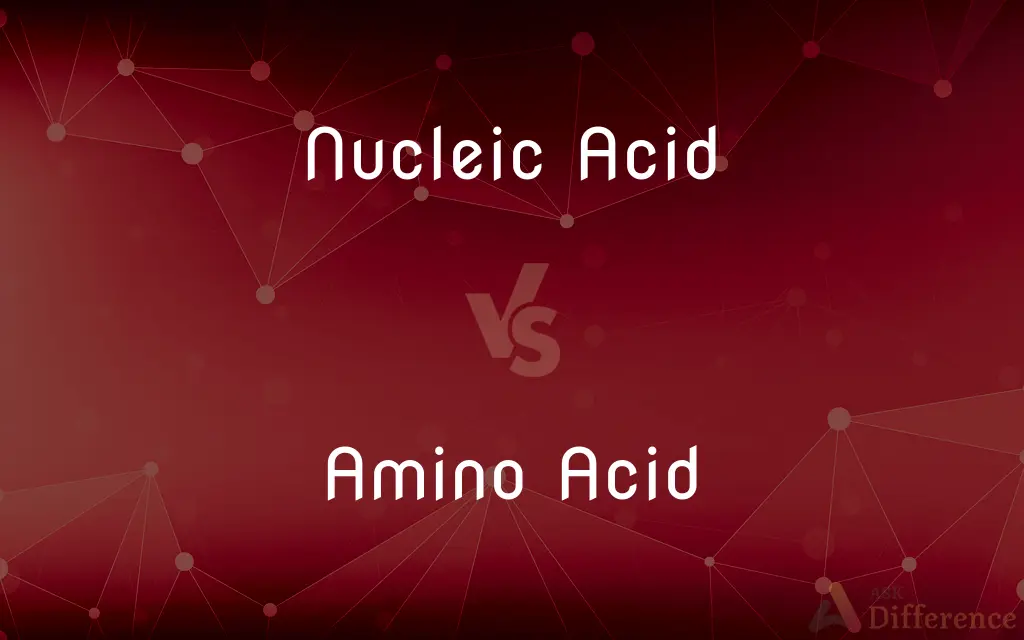Nucleic Acid vs. Amino Acid — What's the Difference?
By Tayyaba Rehman — Published on December 14, 2023
Nucleic acids are macromolecules that store genetic information, while amino acids are building blocks of proteins.

Difference Between Nucleic Acid and Amino Acid
Table of Contents
ADVERTISEMENT
Key Differences
Nucleic acids are complex molecules that play a critical role in the storage and transmission of genetic information. They come in two main types: DNA (deoxyribonucleic acid) and RNA (ribonucleic acid). On the other hand, amino acids are organic compounds that combine to form proteins, which are essential for the structure and function of cells in living organisms.
Both nucleic acids and amino acids are fundamental to life, but they serve different functions. Nucleic acids, in their DNA form, act as the blueprint for an organism, dictating how it should grow, develop, and function. Amino acids, however, are responsible for building the proteins that carry out many of these functions as directed by the DNA.
In terms of structure, nucleic acids are made of nucleotides, each containing a phosphate group, a sugar molecule, and a nitrogenous base. Amino acids, in contrast, consist of a central carbon atom bonded to an amino group, a carboxyl group, and a unique side chain.
Molecules of nucleic acids are often long, with DNA, in particular, forming a double-helix structure. This allows for the storage of vast amounts of information. Amino acids, meanwhile, link together in chains to form peptides or proteins, adopting various shapes that enable them to perform specific tasks in the body.
Lastly, while nucleic acids are primarily found in the cell's nucleus (though RNA can be found in the cytoplasm), amino acids are widespread throughout the cell, often coming together to form complex proteins that are crucial for the cell's structure and function.
ADVERTISEMENT
Comparison Chart
Basic Function
Store and transmit genetic info
Building blocks of proteins
Components
Nucleotides with phosphate group
Central carbon with amino group
Main Types
DNA and RNA
20 standard types in proteins
Location in Cell
Mostly nucleus (RNA in cytoplasm)
Throughout the cell
Structure
DNA is double-helix; RNA is single
Chain forms peptides and proteins
Compare with Definitions
Nucleic Acid
Nucleic acids, like DNA and RNA, carry the instructions for protein synthesis.
Without nucleic acids, cells wouldn't know how to function properly.
Amino Acid
Amino acids are the building blocks for peptides and proteins in organisms.
Insulin, a hormone, is a protein constructed from a specific sequence of amino acids.
Nucleic Acid
Nucleic acids are the hereditary material present in all living cells.
The replication of nucleic acids ensures the transmission of genetic traits to offspring.
Amino Acid
Amino acids are organic compounds that combine to form proteins.
Enzymes, a type of protein, are made up of amino acids and facilitate countless cellular reactions.
Nucleic Acid
Nucleic acids are macromolecules composed of nucleotide chains.
The sequence of nucleotides in a nucleic acid determines genetic information.
Amino Acid
Amino acids are characterized by an amino group, a carboxyl group, and a unique side chain.
The unique side chain of each amino acid determines its properties and role in protein structures.
Nucleic Acid
Nucleic acids are biopolymers essential for life, coding for genetic information.
The discovery of the structure of nucleic acid revolutionized biology.
Amino Acid
Amino acids can be essential (obtained from diet) or non-essential (produced by the body).
Lysine is an essential amino acid, meaning our bodies can't produce it, so we must get it from our diet.
Nucleic Acid
Nucleic acids govern the cell's activities by dictating protein structure and function.
Research on nucleic acids has provided insights into genetic diseases.
Amino Acid
Amino acids play vital roles in metabolism and cellular functions.
A deficiency in certain amino acids can lead to metabolic disorders.
Common Curiosities
How do nucleic acids differ from amino acids in function?
Nucleic acids store and convey genetic information, while amino acids build proteins.
What is an amino acid?
Amino acids are organic compounds that serve as the building blocks for proteins.
Where are nucleic acids found in the cell?
They are mostly found in the nucleus, though RNA is also found in the cytoplasm.
How do amino acids relate to proteins?
Amino acids link together in chains to form proteins.
How many standard amino acids are there?
There are 20 standard amino acids in proteins.
What are the main types of nucleic acids?
The main types are DNA (deoxyribonucleic acid) and RNA (ribonucleic acid).
What is a nucleic acid?
Nucleic acids are macromolecules that store and transmit genetic information.
Are amino acids only involved in protein synthesis?
While their primary role is in protein synthesis, they also play roles in metabolism and other cellular functions.
Can amino acids be synthesized by the human body?
Some can be synthesized, called non-essential, while others must be obtained from the diet, called essential.
How are nucleic acids structured?
They are structured as long chains of nucleotides, with DNA typically forming a double helix.
How do nucleic acids store information?
They store information in the sequence of their nucleotides.
How do mutations in nucleic acids affect organisms?
Mutations can lead to changes in protein structure and function, potentially causing diseases or disorders.
What is the role of RNA in relation to nucleic acids?
RNA, a type of nucleic acid, is responsible for protein synthesis based on DNA instructions.
Why are some amino acids called "essential"?
They are called essential because the body cannot synthesize them, so they must be obtained from the diet.
Do amino acids have a common structure?
Yes, all amino acids have an amino group, a carboxyl group, and a unique side chain.
Share Your Discovery

Previous Comparison
VNTR vs. STR
Next Comparison
Colony Hybridization vs. Plaque HybridizationAuthor Spotlight
Written by
Tayyaba RehmanTayyaba Rehman is a distinguished writer, currently serving as a primary contributor to askdifference.com. As a researcher in semantics and etymology, Tayyaba's passion for the complexity of languages and their distinctions has found a perfect home on the platform. Tayyaba delves into the intricacies of language, distinguishing between commonly confused words and phrases, thereby providing clarity for readers worldwide.












































